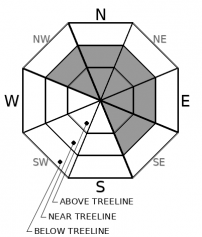| Thursday | Thursday Night | Friday | |
|---|---|---|---|
| Weather: | Mostly cloudy. Scattered snow showers in the morning, then chance of snow showers in the afternoon. Snow levels below 7000 feet. Chance of precipitation is 40%. | Mostly cloudy then becoming partly cloudy. Slight chance of snow showers in the evening. Snow levels below 7000 feet. Chance of precipitation is 15%. | Sunny then becoming mostly cloudy. Chance of snow showers in the afternoon. Snow levels below 7000 feet. Chance of precipitation is 25%. |
| Temperatures: | 34 to 39 deg. F. | 19 to 25 deg. F. | 36 to 42 deg. F. |
| Mid Slope Winds: | Light winds. | Light winds. | Light winds becoming southwest around 15 mph in the afternoon. Gusts up to 25 mph. |
| Expected snowfall: | Up to 1 inch. | SWE = less than 0.10 inch. | No accumulation. . | SWE = trace amounts. | Up to 1 inch. | SWE = less than 0.10 inch. |
| Thursday | Thursday Night | Friday | |
|---|---|---|---|
| Weather: | Mostly cloudy. Scattered snow showers in the morning, then chance of snow showers in the afternoon. Snow levels below 7000 feet. Chance of precipitation is 45%. | Mostly cloudy then becoming partly cloudy. Slight chance of snow showers in the evening. Snow levels below 7000 feet. Chance of precipitation is 15%. | Sunny then becoming mostly cloudy. Chance of snow showers in the afternoon. Snow levels below 7000 feet. Chance of precipitation is 25%. |
| Temperatures: | 30 to 36 deg. F. | 16 to 21 deg. F. | 32 to 38 deg. F. |
| Ridge Top Winds: | Light winds. | West around 15 mph with gusts to 25 mph. | Southwest 15 to 25 mph. Gusts up to 30 mph increasing to 40 mph in the afternoon. |
| Expected snowfall: | Up to 1 inch. | SWE = less than 0.10 inch. | No accumulation. | SWE = trace amounts. | Up to 2 inches. | SWE = less than 0.10 inch. |

























